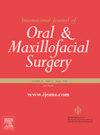Persistent pain after total temporomandibular joint replacement surgery: clinical characteristics, comorbidities, and risk factors
IF 2.2
3区 医学
Q2 DENTISTRY, ORAL SURGERY & MEDICINE
International journal of oral and maxillofacial surgery
Pub Date : 2025-02-01
DOI:10.1016/j.ijom.2024.08.038
引用次数: 0
Abstract
Chronic post-surgical pain (CPSP) after temporomandibular joint (TMJ) surgery is an under-recognized problem. The aim of this study was to document the characteristics of CPSP and identify patient risk factors and comorbidities associated with the development of CPSP after total TMJ replacement (TJR). This was a retrospective cohort study of patients who underwent TJR between 2000 and 2018 at Massachusetts General Hospital, Boston, USA. The primary outcome was the presence of CPSP and use of pain medications after TJR. The secondary outcome was the risk factors associated with the development of CPSP. A total 88 patients were included (79 females, 9 males). The mean follow-up was 4.2 years. Overall, 68 (77.3%) had CPSP and 20 (22.7%) had no CPSP. Of those with CPSP, 32.4% had severe pain and 45.6% continued to take pain medications. Of the 27 patients with data available on the characteristics of the pain, the majority had myofascial pain, while some developed neuropathic pain. A significant difference was noted between the CPSP and non-CPSP groups in terms of preoperative pain, smoking behavior, and use of opioids, non-steroidal anti-inflammatory drugs, muscle relaxants, and neuropathic pain medications.
全颞下颌关节置换手术后的持续疼痛:临床特征、合并症和风险因素。
颞下颌关节(TMJ)手术后的慢性术后疼痛(CPSP)是一个未得到充分认识的问题。本研究旨在记录 CPSP 的特征,并确定与颞下颌关节全置换术(TJR)后发生 CPSP 相关的患者风险因素和合并症。这是一项回顾性队列研究,研究对象是 2000 年至 2018 年期间在美国波士顿马萨诸塞州总医院接受颞下颌关节置换术的患者。主要结果是TJR术后出现CPSP和使用止痛药物的情况。次要结果是与 CPSP 发生相关的风险因素。共纳入 88 名患者(79 名女性,9 名男性)。平均随访时间为 4.2 年。总体而言,68人(77.3%)患有CPSP,20人(22.7%)无CPSP。在患有 CPSP 的患者中,32.4% 有严重疼痛,45.6% 继续服用止痛药。在有疼痛特征数据的 27 名患者中,大多数人有肌筋膜痛,也有一些人出现神经性疼痛。在术前疼痛、吸烟行为以及阿片类药物、非甾体抗炎药、肌肉松弛剂和神经性疼痛药物的使用方面,CPSP 组和非 CPSP 组之间存在明显差异。
本文章由计算机程序翻译,如有差异,请以英文原文为准。
求助全文
约1分钟内获得全文
求助全文
来源期刊
CiteScore
5.10
自引率
4.20%
发文量
318
审稿时长
78 days
期刊介绍:
The International Journal of Oral & Maxillofacial Surgery is one of the leading journals in oral and maxillofacial surgery in the world. The Journal publishes papers of the highest scientific merit and widest possible scope on work in oral and maxillofacial surgery and supporting specialties.
The Journal is divided into sections, ensuring every aspect of oral and maxillofacial surgery is covered fully through a range of invited review articles, leading clinical and research articles, technical notes, abstracts, case reports and others. The sections include:
• Congenital and craniofacial deformities
• Orthognathic Surgery/Aesthetic facial surgery
• Trauma
• TMJ disorders
• Head and neck oncology
• Reconstructive surgery
• Implantology/Dentoalveolar surgery
• Clinical Pathology
• Oral Medicine
• Research and emerging technologies.

 求助内容:
求助内容: 应助结果提醒方式:
应助结果提醒方式:


